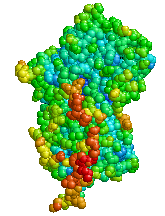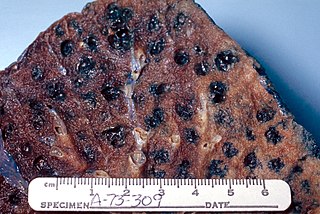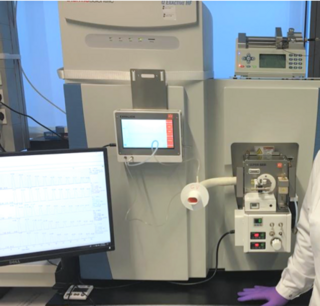
The lungs are the primary organs of the respiratory system in humans and many other animals including a few fish and some snails. In mammals and most other vertebrates, two lungs are located near the backbone on either side of the heart. Their function in the respiratory system is to extract oxygen from the atmosphere and transfer it into the bloodstream, and to release carbon dioxide from the bloodstream into the atmosphere, in a process of gas exchange. Respiration is driven by different muscular systems in different species. Mammals, reptiles and birds use their different muscles to support and foster breathing. In early tetrapods, air was driven into the lungs by the pharyngeal muscles via buccal pumping, a mechanism still seen in amphibians. In humans, the main muscle of respiration that drives breathing is the diaphragm. The lungs also provide airflow that makes vocal sounds including human speech possible.

Sputum is mucus that is coughed up from the lower airways. In medicine, sputum samples are usually used for naked eye exam, microbiological investigations of respiratory infections and cytological investigations of respiratory systems. It is critical that the patient not give a specimen that includes any mucoid material from the interior of the nose.

Alpha-1 antitrypsin deficiency is a genetic disorder that may result in lung disease or liver disease. Onset of lung problems is typically between 20 and 50 years old. This may result in shortness of breath, wheezing, or an increased risk of lung infections. Complications may include COPD, cirrhosis, neonatal jaundice, or panniculitis.
Exhalation is the flow of the breath out of an organism. In animals, it is the movement of air from the lungs out of the airways, to the external environment during breathing.

Spirometry is the most common of the pulmonary function tests (PFTs). It measures lung function, specifically the amount (volume) and/or speed (flow) of air that can be inhaled and exhaled. Spirometry is helpful in assessing breathing patterns that identify conditions such as asthma, pulmonary fibrosis, cystic fibrosis, and COPD. It is also helpful as part of a system of health surveillance, in which breathing patterns are measured over time.

Fructose malabsorption, formerly named dietary fructose intolerance (DFI), is a digestive disorder in which absorption of fructose is impaired by deficient fructose carriers in the small intestine's enterocytes. This results in an increased concentration of fructose in the entire intestine. Intolerance to fructose was first identified and reported in 1956.

Carcinoembryonic antigen (CEA) describes a set of highly related glycoproteins involved in cell adhesion. CEA is normally produced in gastrointestinal tissue during fetal development, but the production stops before birth. Consequently, CEA is usually present at very low levels in the blood of healthy adults. However, the serum levels are raised in some types of cancer, which means that it can be used as a tumor marker in clinical tests. Serum levels can also be elevated in heavy smokers.
Canine cancer detection is an approach to cancer screening that relies upon the claimed olfactory ability of dogs to detect, in urine or in breath, very low concentrations of the alkanes and aromatic compounds generated by malignant tumors.
A hydrogen breath test is used as a diagnostic tool for small intestine bacterial overgrowth and carbohydrate malabsorption, such as lactose, fructose, and sorbitol malabsorption.

Sucrose intolerance or genetic sucrase-isomaltase deficiency (GSID) is the condition in which sucrase-isomaltase, an enzyme needed for proper metabolism of sucrose (sugar) and starch, is not produced or the enzyme produced is either partially functional or non-functional in the small intestine. All GSID patients lack fully functional sucrase, while the isomaltase activity can vary from minimal functionality to almost normal activity. The presence of residual isomaltase activity may explain why some GSID patients are better able to tolerate starch in their diet than others with GSID. The highest prevalence rates are seen in the Inuit populations of Greenland (5–10%), Alaska (3–7%) and Canada. European descent prevalence ranges from 0.2% to 0.05%. There is a lower prevalence reported in African Americans and Hispanics compared to Caucasians.

An electronic nose is a device intended to detect odors or flavors.

Lung cancer screening refers to cancer screening strategies used to identify early lung cancers before they cause symptoms, at a point where they are more likely to be curable. More than 224,000 new cases of lung cancer are expected in the United States in 2016 with approximately 155,000 deaths expected in 2017. 57% were diagnosed in advanced stages where survival is poor. Screening research addresses potential differences in multiple parameters between groups of research subjects with and without screening. Because there is a substantially higher probability of long-term survival following treatment in localized (55%) than in advanced stage (5%), the specific rationale of lung cancer screening is to diagnose the disease in stage I. Research parameters include population cancer-specific mortality, all-cause mortality, long-term survival following diagnosis of cancer, risks of screening and cost-effectiveness. Screening studies for lung cancer have only been done in high risk populations in the U.S., such as smokers and workers with occupational exposure to certain substances. Results from large randomized studies have recently prompted a large number of professional organizations and governmental agencies in the U.S. to now recommend lung cancer screening in select populations.

Major vault protein is a protein that in humans is encoded by the MVP gene. 78 copies of the protein assemble into the large compartments called vaults, illustrated and discussed in the article on Vault (organelle).

In medicine, exhaled nitric oxide (eNO) can be measured in a breath test for asthma or other conditions characterized by airway inflammation. Nitric oxide (NO) is a gaseous molecule produced by certain cell types in an inflammatory response. The fraction of exhaled NO (FENO) is a promising biomarker for the diagnosis, follow-up and as a guide to therapy in adults and children with asthma. The breath test has recently become available in many well-equipped hospitals in developed countries, although its exact role remains unclear.
Exhaled breath condensate (EBC) is the exhalate from breath, that has been condensed, typically via cooling using a collection device. EBC reflects changes in the respiratory fluid that lines the airways and is an inexpensive, non-invasive tool that has potential for scientific research. Despite its promises, it has not been proven for screening or diagnosing diseases of the lung and other conditions, yet. It has long been appreciated that the exhaled breath is saturated by water vapour, but using it for studies of the lung was probably first described in the Russian scientific literature.
Anton Amann was an Austrian chemist and Professor of chemistry at the Innsbruck Medical University. He worked in the area of physical chemistry, ECG analysis, and exhaled breath analysis.
Breath diagnostics involves the analysis of a sample of human breath to monitor, diagnose, and detect diseases and conditions. Besides its primary constituents – nitrogen, oxygen, carbon dioxide and water vapour – exhaled human breath contains over one thousand other compounds at trace levels. Many of these species are formed as the by-products of metabolic processes and can be indicative of a number of different diseases and conditions. Examples of such biomarkers are outlined below:

Chronic obstructive pulmonary disease (COPD) is a type of obstructive lung disease characterized by long-term breathing problems and poor airflow. The main symptoms include shortness of breath and cough with sputum production. COPD is a progressive disease, meaning it typically worsens over time. Eventually, everyday activities such as walking or getting dressed become difficult. Chronic bronchitis and emphysema are older terms used for different types of COPD. The term "chronic bronchitis" is still used to define a productive cough that is present for at least three months each year for two years. Those with such a cough are at a greater risk of developing COPD. The term "emphysema" is also used for the abnormal presence of air or other gas within tissues.
Breath gas analysis is a method for gaining information on the clinical state of an individual by monitoring volatile organic compounds (VOCs) present in the exhaled breath. Exhaled breath is naturally produced by the human body through expiration and therefore can be collected in non-invasively and in an unlimited way. VOCs in exhaled breath can represent biomarkers for certain pathologies. Breath gas concentration can then be related to blood concentrations via mathematical modeling as for example in blood alcohol testing. There are various techniques that can be employed to collect and analyze exhaled breath. Research on exhaled breath started many years ago, there is currently limited clinical application of it for disease diagnosis. However, this might change in the near future as currently large implementation studies are starting globally involving an online e-nose solution: BreathBase®.

Secondary electro-spray ionization (SESI) is an ambient ionization technique for the analysis of trace concentrations of vapors, where a nano-electrospray produces charging agents that collide with the analyte molecules directly in gas-phase. In the subsequent reaction, the charge is transferred and vapors get ionized, most molecules get protonated and deprotonated. SESI works in combination with mass spectrometry or ion-mobility spectrometry.












